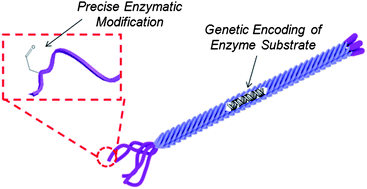Controlled surface immobilization of viruses via site-specific enzymatic modification†
Abstract
A unique method for the controlled attachment of viruses (or other protein based materials) to a range of surfaces is revealed through site-specific linkages engineered at the fd phage p3 protein coat. After genetic encoding of the virus coat position that is to be engineered, enzymatic modification with a formylglycine generating enzyme (FGE) affords the conversion of a single amino acid at a precise location to yield a reactive aldehyde group. By implementing this modification at a specific p3 coat position, we demonstrate the ability to control the directed immobilization of the virus selectively onto amine exposed surfaces including APTES treated glass, polymeric supports, and protein coated magnetic beads. While the immobilized virus remains stable for even a month, we also show by controlled release from the surface that liberated viruses retain their infectivity. The adaptability of this modification strategy for virus engineering is demonstrated showing great potential for bioconjugation with a range of amine functionalized chemical targets. This is expected to greatly enhance the possibilities for future virus based materials and related technologies.


 Please wait while we load your content...
Please wait while we load your content...